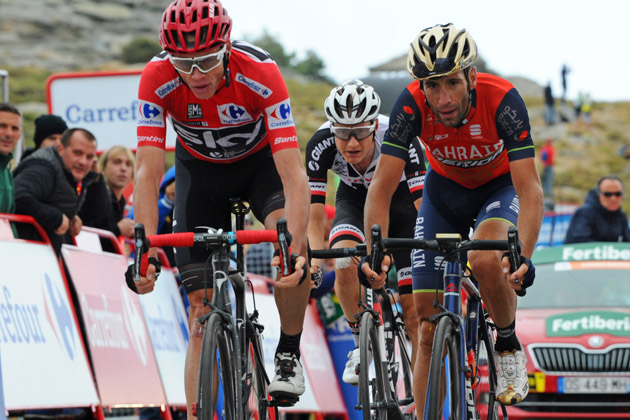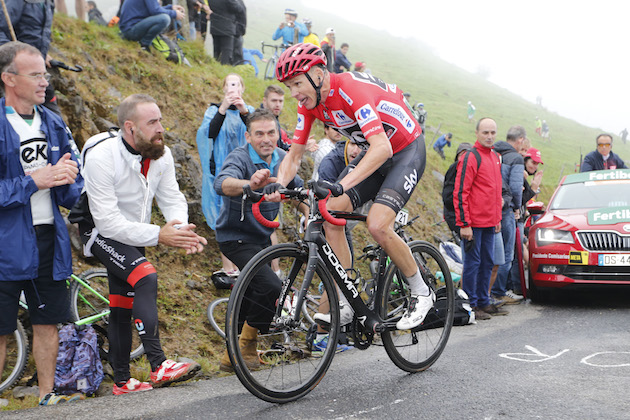Four reasons why Chris Froome could still lose the Vuelta a España
The 2017 Vuelta a España overall victory is not a foregone conclusion for Chris Froome just yet

Chris Froome, Wilco Kelderman and Vincenzo Nibali, Vuelta a España 2017.
His lead is now slight
Following Tuesday’s time trial, it had looked as though this year’s Vuelta a España was set to buck the trend of recent editions – a domineering time trial stage win by Chris Froome (Sky), who had looked in complete control virtually all race, saw his overall lead grow to a seemingly unassailable 1-58, which would stand as the biggest margin of victory for 10 years at this typically closely-fought Grand Tour.
Suddenly, having endured a jour sans up the punishing slopes of Los Machucos, Froome’s buffer has been slashed to just 1-16 ahead of second place Vincenzo Nibali (Bahrain-Merida), and it looks as though the race will go down to wire after all.
>>> Vincenzo Nibali: Chris Froome showing ‘no sign of weakness’ despite time loss
The 1-16 remains a handy lead and Froome is still clearly favourite to wrap up overall victory, but what had seemed almost like a procession to Madrid has now become a lot more complicated.
His form might be wavering

We’re used to seeing Froome drop back and pace himself on summit finishes, especially one as steep as Machucos, but what was worrying today was how he continued to lose ground towards the peak. This was not a case of Froome managing his efforts – you could tell just by looking at the facial expressions being pulled that he had gone into the red, and had for once lost control of proceedings.
Froome also has a history of growing weaker towards the end of a Grand Tour. At the 2015 Tour de France, he lost 1-58 of his overall lead to nearest competitor Nairo Quintana (Movistar) during two final week stages in the Alps. Similarly, in 2013 he lost 1-55 to the same rider across the last three days in the mountains.
If that pattern is repeating itself – with Nibali in the Quintana role – there is enough time yet for Froome to be in danger of losing his overall lead come Madrid.
The latest race content, interviews, features, reviews and expert buying guides, direct to your inbox!
The Alto de l'Angliru is still to come
Neither Thursday or Friday’s stages should pose too much of a worry to Team Sky and Froome. The former features nothing more severe than a category two ascent, with a climb to the finish too gentle to instigate gaps of anything more than a few seconds, while the latter’s sole category one climb is got out the way with over 120km still to ride, and culminates in a neutralising descent to the finish.
The Alto de l‘Angliru tackled on Saturday is an altogether more serious matter. Long-anticipated and described my many as most difficult climb in professional cycling, the Angliru is so hard that a gap as slender as Froome’s over Nibali’s could be effectively wiped in mere kilometres, especially during the second half’s sustained gradient of well over 10 per cent.
>>> Seven toughest climbs of the 2017 Vuelta
On slopes like these, even the slightest difference in form between riders will be enough to differentiate them, as both have discovered in the past. In 2013, a closely matched Nibali and Chris Horner were separated by 28 seconds, while Froome lost 48 seconds – and ultimately the overall win – to Juan Jose Cobo in 2011.
If Nibali replicates his form over Los Machucos on the Angliru and Froome fails to improve, the Italian could yet be crowned champion at the summit.
Vincenzo Nibali is a fearsome rival

Nibali was not the only rider to gain time over Froome on stage 17, but he does appear to be the only rider still within striking distance of his lead.
Wilco Kelderman (Sunweb) and Ilnur Zakarin (Katusha-Alpecin) have been content to ride defensively, and would have to rely on Froome collapsing spectacularly for their respective deficits of 2-13 and 2-25 to close up.
Alberto Contador (Trek-Segafredo) and Miguel Angel Lopez (Astana) may have demonstrated an ability to drop Froome on the climbs, but at 3-34 and 4-39 behind they’re both surely too far down the GC to still pose a threat.
>>> Vuelta a España 2017: Latest news, reports and race info
Nibali, on the other hand, is riding like someone who firmly believes he can still win the overall. He’s a fearsome competitor and will look to gain time whenever he can, even on the stage prior to the Angliru, and will constantly be on the look-out to exploit whatever weakness Froome might betray.
Whereas Froome tends to get weaker in the final week of a Grand Tour, Nibali enjoys the reverse advantage of growing stronger. At the 2016 Giro d’Italia, for instance, he spectacularly emerged from fourth place overall at 4-43 down to win the pink jersey in the space of just two days.
By comparison, winning this Vuelta would require a much less dramatic turnaround.
Stephen Puddicombe is a freelance journalist for Cycling Weekly, who regularly contributes to our World Tour racing coverage with race reports, news stories, interviews and features. Outside of cycling, he also enjoys writing about film and TV - but you won't find much of that content embedded into his CW articles.